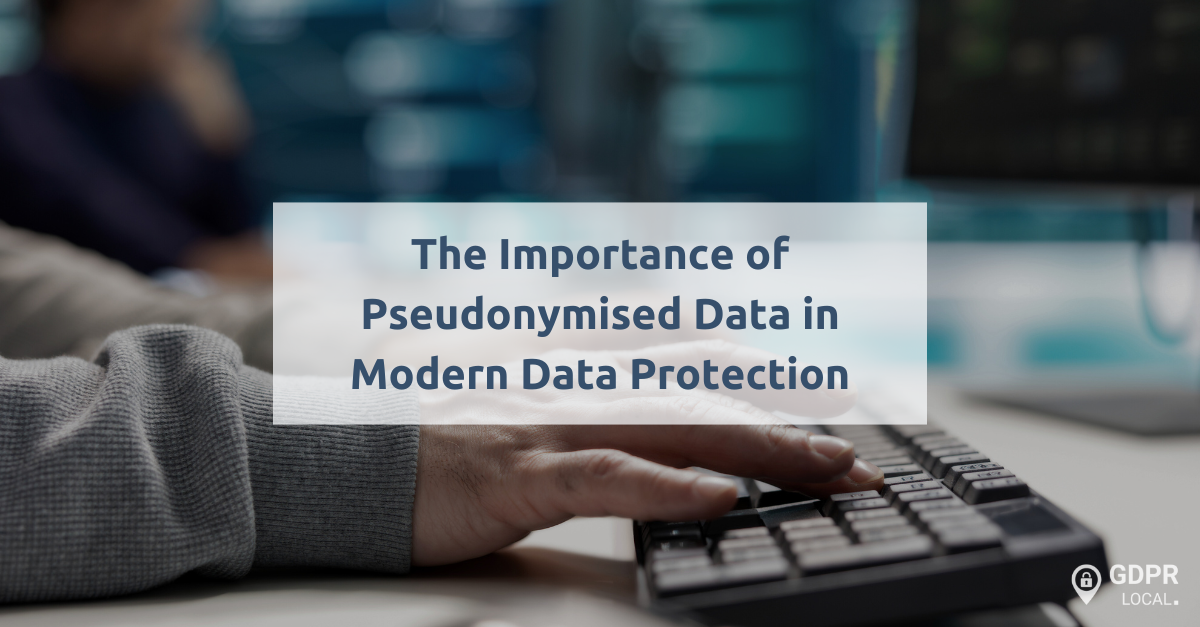
The Importance of Pseudonymised Data in Modern Data Protection
Pseudonymised data replaces personal identifiers with codes, helping protect privacy while allowing data analysis. However, it remains personal data under GDPR, requiring compliance with privacy laws. This article explains pseudonymised data, its benefits and limitations, and how it differs from anonymisation.
Key Takeaways
• Pseudonymised data, although protected, remains classified as personal data under GDPR, requiring strict compliance with data protection laws.
• It provides significant advantages for data analysis while maintaining privacy, but it also carries inherent risks of re-identification if not appropriately managed.
• To effectively implement pseudonymisation, organisations must employ suitable technical measures, conduct regular audits, and maintain transparency with data subjects.
What is Pseudonymised Data

Pseudonymised data is a cornerstone of modern data protection strategies, offering a way to process personal data while minimising risks. Replacing personal identifiers with unique codes allows pseudonymised personal data to be analysed while keeping identities hidden. Despite its transformation, pseudonymised data is still considered personal data under GDPR, necessitating compliance with data protection laws.
Understanding the definition of pseudonymisation and its differences from anonymisation is crucial for grasping the concept entirely. These nuances are crucial for ensuring data protection measures are correctly implemented and compliant with regulations.
Definition of Pseudonymisation
Pseudonymisation is a process that transforms personal data so that it can no longer be attributed to a specific data subject without additional information. This additional information, which could re-identify individuals, must be kept separately and protected by technical and organisational measures. Key-coding data or employing encryption with a secret key are common techniques used in pseudonymisation.
Despite its protective measures, pseudonymised data remains classified as personal data under the UK GDPR, which means organisations must adhere to data protection regulations when handling it. The objective is to anonymise personal data to unauthorised parties, protecting individual privacy while permitting data use for legitimate purposes that constitute personal data rendered anonymous.
Differences from Anonymisation
Distinguishing pseudonymisation from anonymisation is important. While pseudonymised data can potentially be traced back to an individual through additional information, anonymisation renders this impossible. Anonymised data, as defined under UK GDPR, does not relate to an identified or identifiable individual. For data to be considered truly anonymised, it must be stripped of enough elements so that the data subjects are no longer identifiable.
Pseudonymised data carries a residual risk known as the re-identification risk, which is the possibility that individuals could be identified if the necessary additional information is accessed. The motivated intruder test can assess this risk and evaluate the feasibility of re-identifying individuals based on available resources and data.
Benefits and Limitations of Pseudonymisation
Pseudonymisation offers several benefits, making it a valuable tool in data protection. It allows organisations to analyse data trends while maintaining user confidentiality, thus facilitating improved data analysis without compromising individual privacy.
However, some limitations must be considered in order to understand its effectiveness and potential risks fully.
Advantages of Pseudonymisation
One of the primary advantages of pseudonymised data is its ability to support various functionalities, such as analytics and customer engagement, while protecting personal information. Pseudonymisation helps organisations maintain data utility for analysis and other legitimate purposes, enhancing customer trust and demonstrating a commitment to data protection.
Disadvantages of Pseudonymisation
However, pseudonymisation does have limitations. A significant drawback is the persistent risk that determined attackers could re-identify anonymised data. Confusing pseudonymisation with anonymisation can lead to a false sense of security. This misunderstanding risks the re-identification of personal data.
Additionally, the complexity involved in implementing pseudonymisation and the potential reduction in data utility are challenges that organisations must navigate.
Pseudonymised Data in Practice
Pseudonymised data is applied across various sectors, each leveraging its benefits to process personal data while minimising risks. From medical research to marketing and public administration, pseudonymisation enables organisations to derive valuable insights while maintaining data subject privacy.
Medical Research
In medical research, pseudonymised data allows researchers to analyse patient outcomes without linking data to specific patients, thus preserving privacy. This approach enables the study of health trends and treatment effectiveness while ensuring that patient identities remain confidential.
Safeguarding individual privacy through pseudonymisation facilitates valuable insights and advancements in healthcare.
Marketing and Analytics
Marketers utilise pseudonymised data to tailor advertisements and evaluate campaign performance without compromising personal customer information. Analysing consumer behaviour and preferences allows businesses to personalise campaigns while minimising privacy risks associated with identifiable information.
This balance allows organisations to gain valuable insights from data while effectively addressing privacy concerns.
Public Authorities
Public authorities leverage pseudonymised data to develop policies and conduct statistical analyses while safeguarding individual identities. Government agencies employ this data for demographic studies, ensuring data privacy during policy development and statistical analyses.
This enables informed decision-making without compromising citizen information.
Legal Considerations and Compliance
Pseudonymised data remains classified as personal data, subject to data protection laws. Pseudonymisation aids in adhering to privacy regulations by minimising unauthorised data access.
Understanding these legal requirements is essential for ensuring compliance with data protection obligations and protecting personal data effectively.
GDPR Requirements
Under GDPR, organisations must ensure that pseudonymised data is processed in a manner that complies with data subject rights. Controllers must implement appropriate safeguards when processing pseudonymised data to uphold the rights of data subjects.
Future regulatory frameworks may impose stricter guidelines on using and sharing pseudonymised data to ensure better protection of personal information.
Technical and Organisational Measures
Article 32 of GDPR emphasises the importance of implementing suitable technical and organisational measures to maintain data security, including pseudonymisation. Effective security protocols should be in place to ensure that pseudonymised data cannot be re-identified without additional information.
Organisations must regularly review and update their technical measures to protect pseudonymised data from unauthorised access.
Data Breaches
Organisations must fulfil specific notification obligations under GDPR in a data breach involving pseudonymised data. Organisations must notify the relevant authorities if the data can still be linked to individuals.
If a breach poses a significant risk to individuals, the affected parties must be notified immediately.
Best Practices for Implementing Pseudonymisation
The effective implementation of pseudonymisation requires its integration into data processing operations as early as possible. This includes using a pseudonymisation key that securely links pseudonyms to their original values, stored in a separate location.
Choosing the Right Methods
The selection of pseudonymisation techniques should consider data type, processing context, and regulatory compliance. Implementing pseudonymisation can be costly and complex, particularly for large datasets requiring additional technical resources.
Machine learning algorithms can streamline identifying and applying pseudonymisation methods on large datasets.
Maintaining Data Security
Regular audits are crucial for identifying vulnerabilities in managing pseudonymised data and ensuring compliance with security standards. Access controls, which should limit who can view or manage pseudonymised data, are essential for protecting sensitive information.
Regular audits and access control measures are crucial in safeguarding pseudonymised data from unauthorised access.
Documentation and Transparency
Documentation of all data breaches is mandatory, regardless of whether they are necessary for reporting to regulators. Transparency with data subjects about pseudonymisation practices helps build trust and ensures compliance with data protection regulations.
Being transparent about pseudonymisation processes promotes data protection compliance and enhances individual trust.
Pseudonymisation vs Other Data Protection Techniques
Pseudonymisation is recognised as a method to mitigate risks in processing personal data under GDPR. Comparing it with other data protection techniques like encryption and tokenisation can help organisations choose the most suitable method for their needs.
Encryption
Encryption methods, such as symmetric or asymmetric encryption, should be considered when creating pseudonyms to ensure data security. Emerging encryption methods, like homomorphic encryption, allow computations on pseudonymised data without exposing the underlying personal data.
While pseudonymisation retains the possibility of re-identification, encryption often prevents meaningful access without the key.
Tokenisation
Tokenisation is another method that replaces sensitive data with unique identifiers or tokens, allowing for information retrieval while maintaining protection. Unlike pseudonymisation, tokenisation ensures that the original data can only be retrieved under strict controls, providing higher security.
In tokenisation, the mapping between the original sensitive data and its token is stored securely, ensuring the data remains protected. This method can be beneficial for maintaining referential integrity in databases while providing data privacy.
Future Trends in Pseudonymised Data
The future of pseudonymised data is closely tied to technological advancements and evolving regulatory landscapes. The increasing integration of artificial intelligence and machine learning is expected to enhance the effectiveness of pseudonymisation by automating the identification of sensitive data elements.
These technological advances will help maintain a balance between data utility and privacy.
Technological Advances
Emerging technologies are improving pseudonymisation methods, making protecting personal data easier while allowing for analysis and use. New algorithms are being developed to enhance the effectiveness of pseudonymisation by making re-identification more difficult.
These advancements enhance the efficiency and reliability of pseudonymisation techniques, enabling better personal data protection.
Regulatory Changes
Future regulations may necessitate enhanced cooperation between data protection and competition authorities to manage the intersection of data privacy and market dynamics effectively. Anticipated updates to privacy laws will likely impose stricter requirements on data controllers regarding the transparency and accountability of pseudonymisation practices.
These regulatory changes will significantly impact how organisations manage and protect pseudonymised data.
Summary
Pseudonymised data plays a pivotal role in modern data protection, offering a way to balance data utility with privacy. Organisations can make informed decisions about their data protection strategies by understanding the differences between pseudonymisation and anonymisation and acknowledging the benefits and limitations. Practical applications in fields like medical research, marketing, and public administration highlight the versatility of pseudonymisation.
Legal considerations, especially under GDPR, emphasise the need for compliance and robust security measures. Implementing best practices, such as choosing the correct methods, maintaining data security, and ensuring transparency, can help organisations effectively manage pseudonymised data. As technology and regulations evolve, staying informed about future trends will be crucial for maintaining data privacy and protection. Embrace pseudonymisation as a regulatory requirement and a commitment to safeguarding individual privacy in the digital age.
Frequently Asked Questions
What is an example of Pseudonymized data?
An example of pseudonymised data is replacing a user’s name with a pseudonym or reference number in a dataset, which safeguards privacy while allowing for meaningful data use.
Will pseudonymised data usually include names and addresses?
Pseudonymised data typically does not include real names and addresses, as it replaces identifying information with artificial identifiers to protect privacy. This process minimises concerns regarding data sharing and retention.
How does pseudonymisation differ from anonymisation?
Pseudonymisation permits data to be traced back to an individual through confidential information, while anonymisation effectively removes identifiable elements, making it impossible to identify individuals. Thus, pseudonymisation maintains a link to identity, whereas anonymisation completely severs that connection.
What are the GDPR requirements for pseudonymised data?
GDPR requires that pseudonymised data be processed by data subject rights and that adequate safeguards are in place to protect any information that could identify individuals. Compliance with these requirements is essential to ensure privacy and data protection.
How can organisations maintain data security for pseudonymised data?
Organisations should conduct regular audits, enforce strict access controls, and implement appropriate technical and organisational measures to maintain data security for pseudonymised data. This comprehensive approach ensures the protection of sensitive information and compliance with security standards.